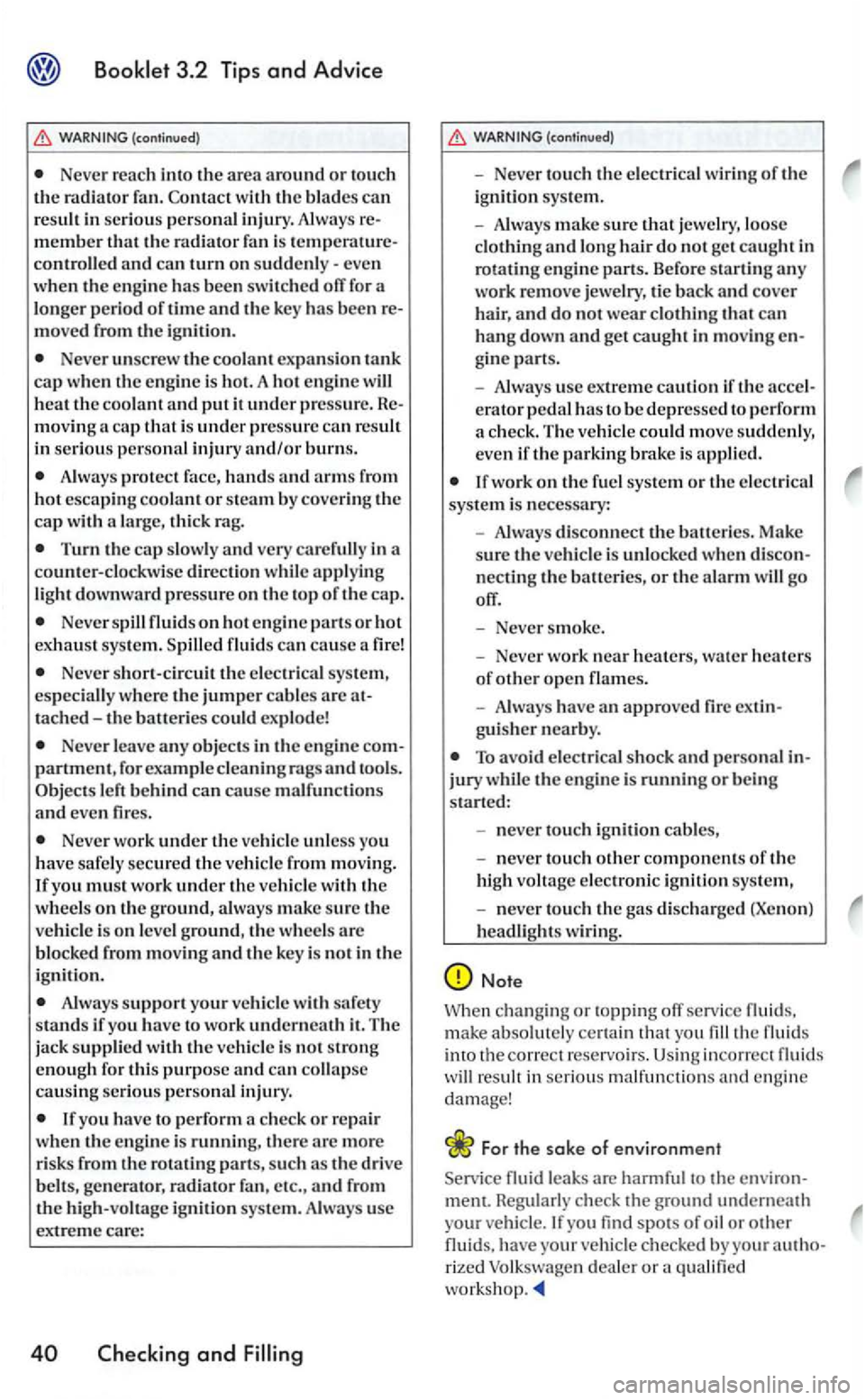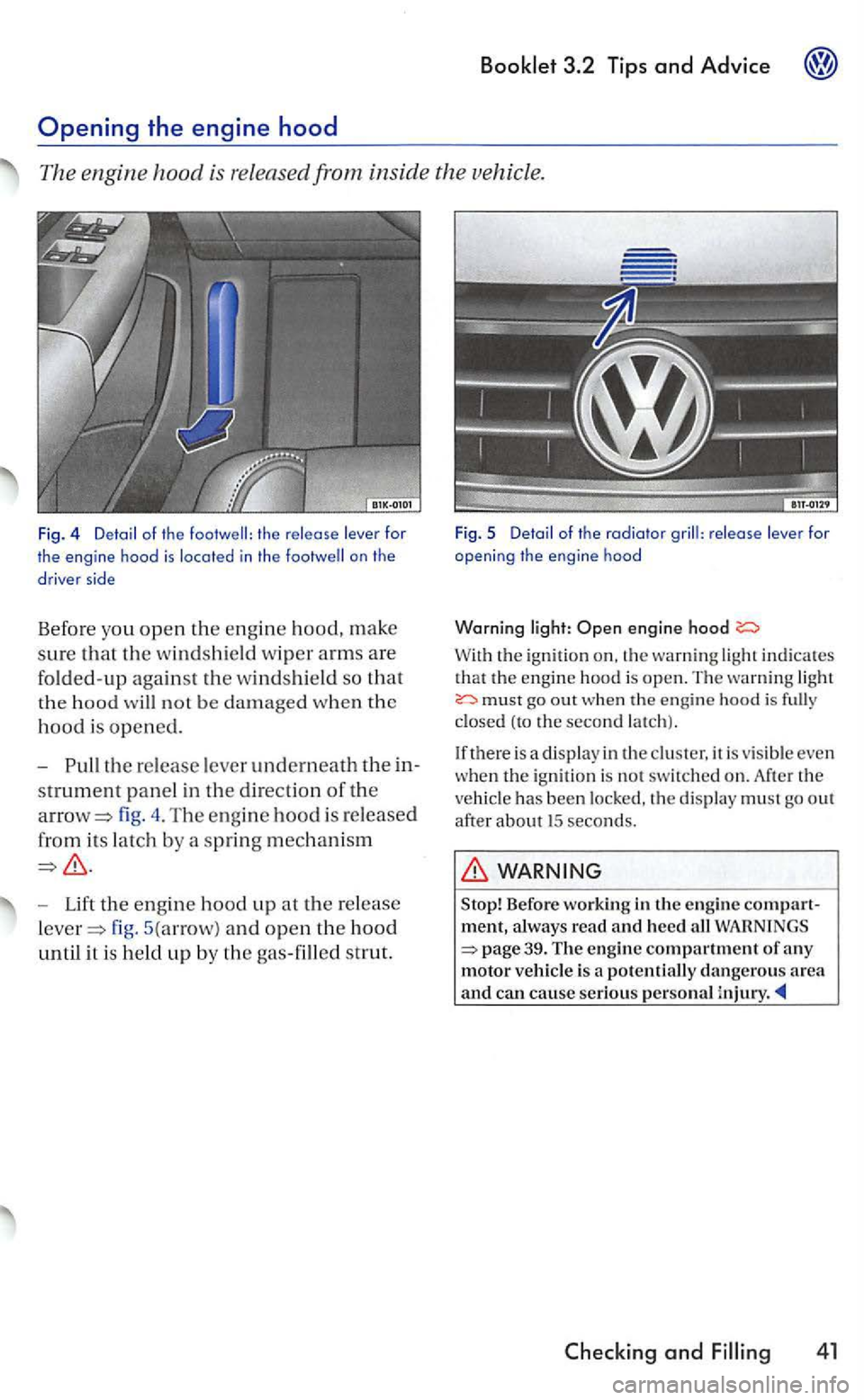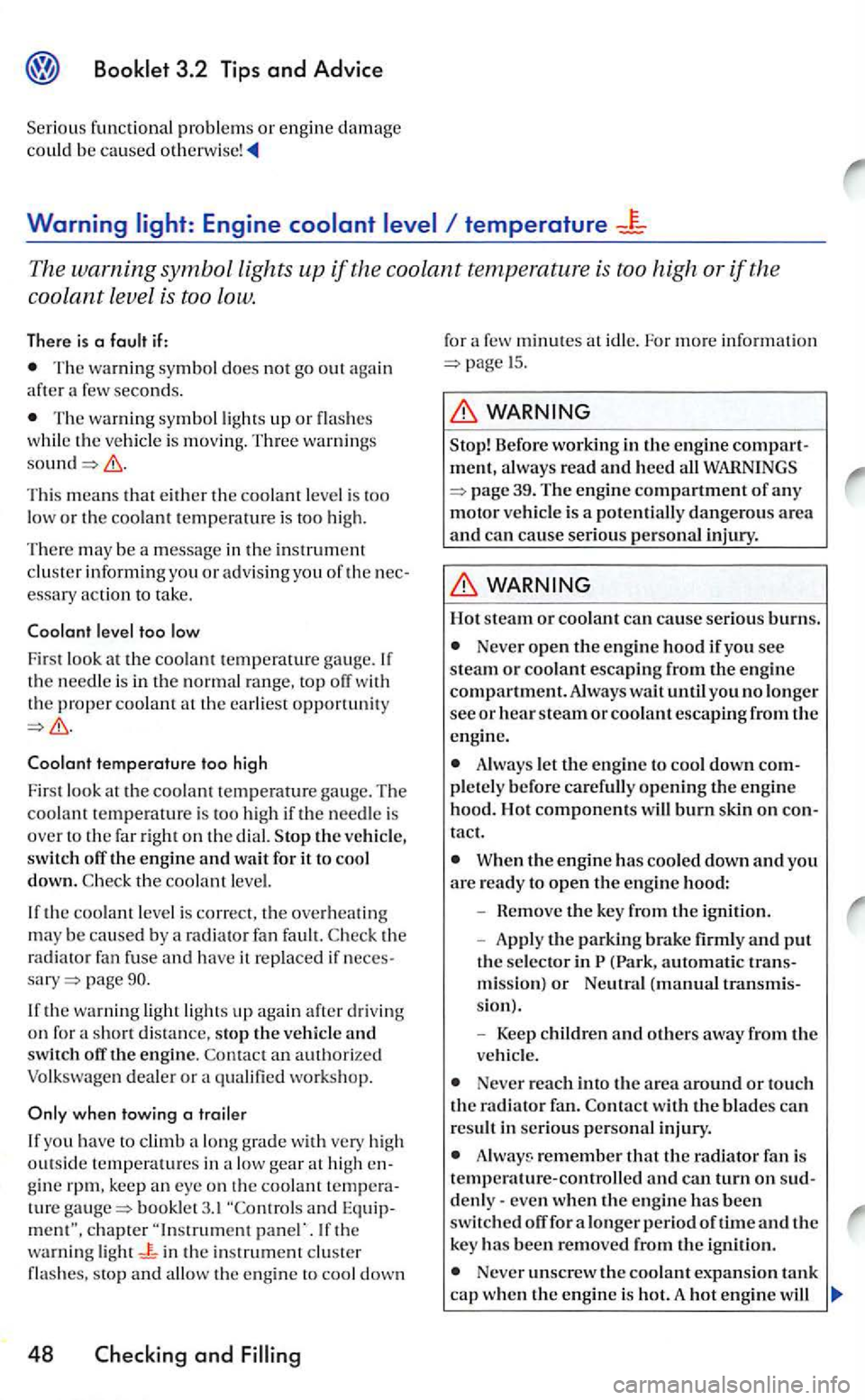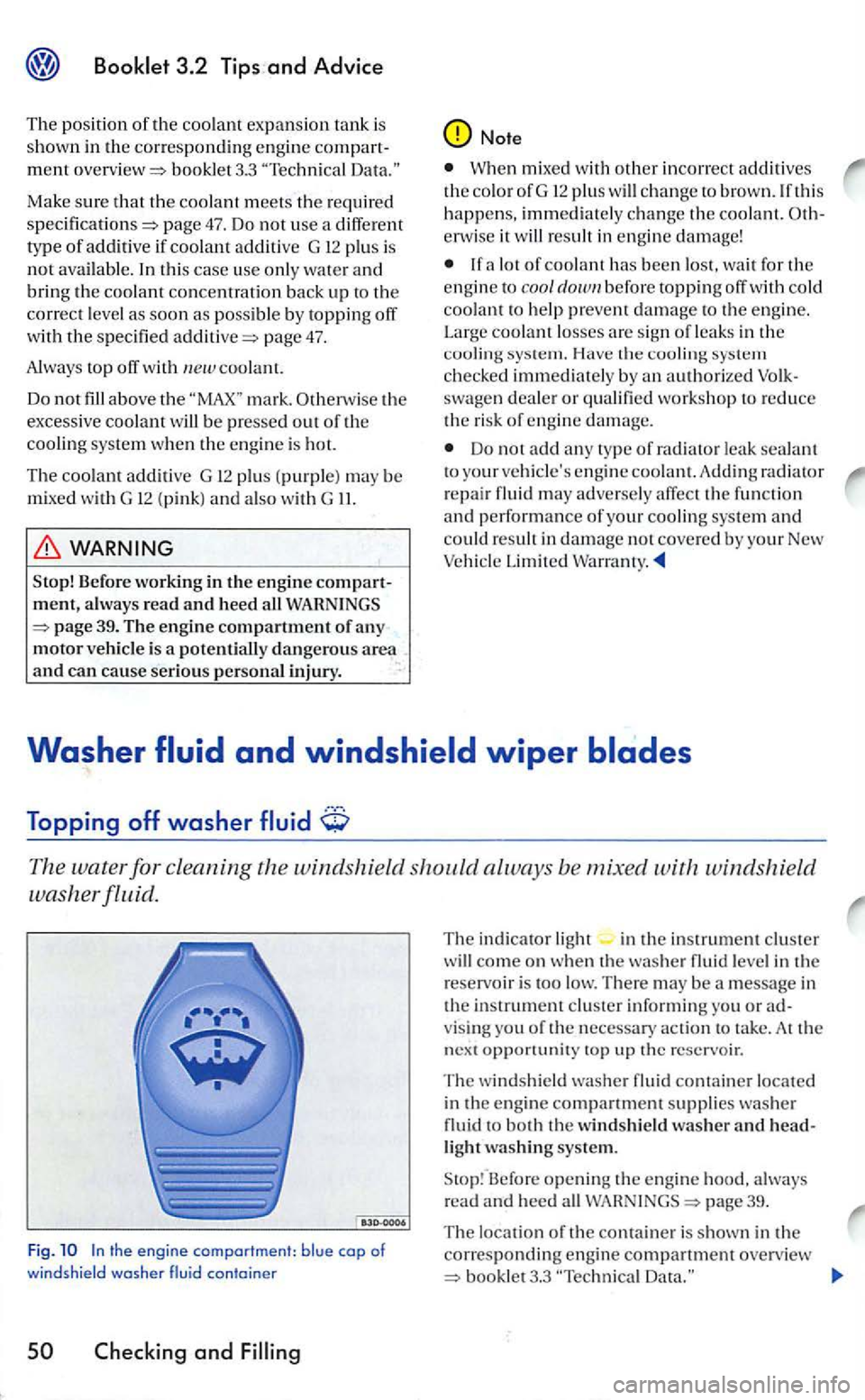2008 VOLKSWAGEN GOLF radiator
[x] Cancel search: radiatorPage 316 of 444

WARNING (continued)
Never reach into the area around or tou ch the radiator fan. Contact w ith the blade s can resuh in se riou s personal injury. Always m ember that the radiator fan is controll ed and can turn on
m oved from the ignit ion.
Never unscrew the coolant expa nsio n tank cap when th e engin e is hot. A hot engine will heat the coo la nt and put it under pressure . mov in g a cap that i s under pressure ca n rcsuh in seriou s personal injury and/or burns.
A lway s prote ct face, hand s and arms from hot esca ping coolant or steam b y cove ring the ca p with a large, thick rag.
Turn the cap slow ly a nd very carefully in a
counter- clo ckw ise direction whil e applying
light downward pressure on the top of the cap.
Never spill on hot engine parts o r hot
e xhau st sys te m . S pilled
Neve r short-circuitthc elec trica l sys te m ,
es peciall y w here th e jumper cabl es are tached -th e balleri es could explode!
Neve r leave any objects in the e ngine partment, for exam ple cleaning rag s and too ls. Objects
Neve r work unde r the veh ic le unless you
h ave safely secured th e ve hicl e from movin g.
I f yo u must work under th e ve hicl e wit h th e
w hee ls on th e ground, always make sure the vehicl e is on leve l ground, th e wh eels arc
b locked from movin g and th e key is not in the
ignition.
Always support your ve hicle with safety
s tands if you have to wo rk underneath it. The
ja ck suppli ed with the ve hicle is not s tron g enough for this purpose and can co llap se causin g se riou s personal injury.
If you have to perform a check or r ep a ir
w hen th e e ngine is running, there arc more
ri sks from
the ro tating parts, such as the drive
WARNING (con tinued)
Neve r to uch the e lec tr ica l w ir in g of the ig ni tio n sys tem.
Always make sure that j ewe lry, loose clothing and lo ng hair do not get caught in
rota ting engine pans. Before startin g any work remove jewelry, tie back and cover
hair, and do not wear clothing that can hang down and get caught in mov ing gin e parts.
Always use extre me cauti on if the erator pedal has to be depresse d to perform
a ch eck. The vehicle could move suddenly, eve n if the parking brake is applied.
If wor k on the fu el sys te m or th e electrica l
syste m is necessa ry:
Always discon nect th e balleries. Make
sure th e vehicle is unlo cked when
Neve r sm oke .
Neve r work nea r heaters, wa te r h eaters of other open names .
A lways have an approve d fire ext guis her nearby.
To avo id electrical shock and personal jury w hil e the eng ine is running or being
s tarted :
n ever touch ignition cables,
never to uch othe r component s of the
high vohage electronic ignition syste m,
never touch the gas discharged (Xeno n) headlights wiring.
Note
Whe n chang ing or topp ing orr service fluids. make absolutel y ce rtain that you fill the fluid s
into the corr ect reservoirs. Using incorrec t fluids will resuh in serious malf unct ions and engine
damage!
For the sake of environment
Service fluid leaks are harmful to the environ-
ment. Reg ularl y check the ground undernea th
your vehicle . you find spots of oil or other
fluids. have your vehic le checked by your rized dealer or a qualified
Page 317 of 444

Booklet 3.2 Tips and Advice
th e release lever for
the engine hood is located in the on the
d rive r side
Befor e you open the engine hood, make
sure that the w indshi eld wiper arms are
folded-up against the winds hi eld so that
the hood will not be damaged when the
hood is opened.
fig . 4 . The engi ne hood is released
from its latch by a s
pring mechanism
Lift the engin e hood up at the re lease
fig. 5(arrow) and open the hood
until it is held up by the gas-filled strut.
Fig . 5 Detail of the radiator release lever open ing the en gine hood
Warning engine hood
With the ignition on, the warnin g light indicate s
that the engine hood is open. The warning light must out when the engine hood is closed (to the second latch ).
If there is a displa y
in the cluster, it is visible even
when the ignit io n is not switched on. After the
vehicle has been locked, the disp lay must go out after about 15 seconds .
WARNING
Before working in lhe engine compartment, always read and heed all WARNINGS 39. The engine compartment of any motor vehicl e is a potentially dangerous area and can cause se riou s personal injury.
Page 324 of 444

Booklet 3.2 Tips and Advice
functional problem s or engine damage could be caused
Warning temperature
The warning symbol lights up if the coolant temperatur e is too high or if the
coolant level is too
Low.
Ther e is a fault if:
The wa rnin g symbol does not go out aga in afte r a few seconds.
The wa rnin g symbol light s up or flas hes whil e the vehicle is moving. Three warning s
This means th at eith er th e coolant leve l is too low or the coo lant temperature is too high.
Th ere may be a m essage in the i
nstrument
clu ste r inf orming you or advi sing you of th e
Coolant temperature too high
Fir st look at the coolan t tempe rature gau ge. The coolant temperature is too hi gh if th e need le is
o ver to th e fa r right on the dial. the vehicle,
switc h the engine wait for it to cool down. the coo lant level.
I f th e coo lant level is co rrect, th e over heating may be caused by a radia tor fan fault. the ra diator fan fuse and have it replaced if page
If th e wa rnin g light lights up again after driving
o n for short distan ce, stop the vehicle switch otT th e e ngine. an authorized Volkswagen dea le r or a qu alified worksh op.
when towing a trailer
If you have to c limb a lo ng g rad e w ith high temperatures in low gea r at high gin e ture booklet 3. 1 and If th e
w arning light in th e in st rument cluster flas hes, stop and a llo w the e ngine to coo l down
48 Checking and Filling
for minutes at idl e. For more inform ation 15.
alw ays read and heed all
Hot steam or coolant ca n cause seriou s burns.
Neve r open the engine hood if you see steam or coolant escaping from the engine compartment. Always wait until you no longe r see or hear steam or coolant escaping from the
e n gine.
Always let the engine to cool down pl ete ly before carefully opening the engin e hood. Hot components will burn tact.
When the engine has coo led down and you are ready to open the engine hood:
-
move the key f rom the ignitio n.
- Appl y
the parking brake firmly and put the selector in ( Park, automatic mission) or Neutral (manual
Never reach into the area around or tou ch
th e rad iator fan. with the blades ca n
re sult in serio us personal injury.
remembe r th at the radiator fan is temperature-controlled and can turn on
fo r a longer p eriod of tim e and the
key has been r emoved fro m the ig nition.
Never unscrew the coola nt expansion tank cap when the e ngin e is hot. A hot engine will
Page 326 of 444

booklet 3.3 ''Te chnical
page 47. Do not use a diffe rent
t y p e of additive if p lu s is not available. t his case use only wate r a nd bring the coolant concen trat ion back up correct level as soon a s poss ible by topping off wit h s pecified page 47 .
Alway s
mark. the
excessi ve coola nt will b e presse d out of cooling syste m when
Stop! Before working in the engine compartment, always read and heed all
W hen mixed w ith other incorrect additives co lo rofG 12 plus w ill ch a nge brown.
w ill res ult in engine damage!
has been engine coo l engine.
L arge coolan t lo sses are sig n of leaks in the cooling sys tem. Have th e cooling sys tem check ed
Do not add any type of leak sealant
t o your ve hicle's engine coolant. Adding radiator re pair fluid may adversely
The water for cleaning th e windshield shou ld alway s be mixed with windshield
washer fluid.
Fig. the engine comportment: b lue cop of w indshie ld washer container
The in dicator ligh t in cluster come on w he n the was her fluid leve l in th e
r eservoir is
cluster informing you or a d
v is in g yo u of the next opportunity top up the reservo ir.
The wind shield washe r flu id locat ed
i n engin e compartment suppli es was he r fluid t o both windshield washer and hea d
li ght washing system.
Before opening the engine page 39.
T he loca
tion of th e conta iner is shown in th e
corresponding engine bookle t3.3 "Tec hnica l